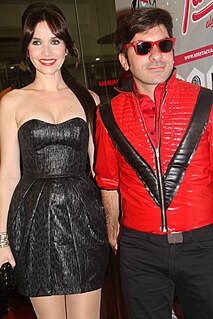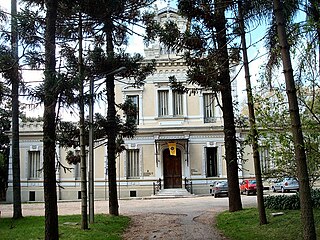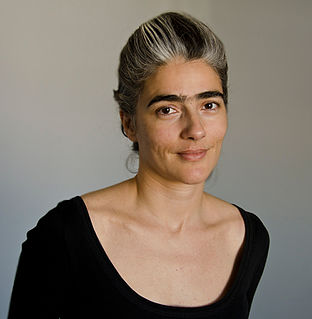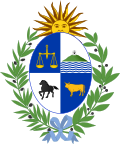
Montevideo is the capital and largest city of Uruguay. According to the 2011 census, the city proper has a population of 1,319,108 in an area of 201 square kilometers (78 sq mi). Montevideo is situated on the southern coast of the country, on the northeastern bank of the Río de la Plata.

A maritime museum is a museum specializing in the display of objects relating to ships and travel on large bodies of water. A subcategory of maritime museums are naval museums, which focus on navies and the military use of the sea.

Joaquín Torres García was a Uruguayan-Spanish artist who was born in Montevideo, Uruguay. Torres-García emigrated to Catalunya, Spain as an adolescent, where he began his career as an artist in 1891. For the next three decades, Torres-García embraced the Catalan identity and led the cultural scene in Barcelona and Europe. As a painter, sculptor, muralist, novelist, writer, teacher, and theorist, Torres-García was considered a "renaissance" or "universal man." He used a simple metaphor to deal with eternal struggles he faced between the old and the new, between classical and avant-garde, between reason and feeling, and between figuration and abstraction: there is no contradiction or incompatibility. Like Goethe, Torres-García sought to integrate classicism and modernity. Although he lived and worked primarily in Spain, Torres-García was also active in the United States, Italy, France, and Uruguay; he influenced European and North American and South American modern art.

Martín Sastre is a Uruguayan film director and contemporary media artist working with film, video, sculpture, photography and drawing.

Ciudad Vieja is a historic neighbourhood in Montevideo, the capital of Uruguay. Located in a peninsula at the entrance of the natural port of Montevideo it was founded in 1724 as a walled city by the Spanish Empire, after the independence of Uruguay the city rapidly grew outwards and the Ciudad Vieja remained as one of the central neighbourhoods, nowadays it serves as one of the main office districts of Montevideo, housing multiple banks and institutions, but also as one of main tourist attractions in Uruguay due to its historical significance and classical architecture.
Luis Camnitzer is a German-born Uruguayan artist, curator, art critic, and academic who was at the forefront of 1960s Conceptual Art. Camnitzer works primarily in sculpture, printmaking, and installation, exploring topics such as repression, institutional critique, and social justice. For over five decades, his practice has explored the psychological and political dimensions of language.
Devincenzia is an extinct genus of giant flightless predatory birds in the family Phorusrhacidae or "terror birds" that lived during the Early Miocene (Deseadan) Fray Bentos Formation of Uruguay and Late Miocene (Huayquerian) Ituzaingó Formation to Early Pliocene (Montehermosan) of Argentina. The type species D. pozzi was formerly known as Onactornis pozzi. A second species D. gallinali has been described. It stood about 2.5 metres (8.2 ft) tall.

Águeda Dicancro was a Uruguayan sculptor from Montevideo, noted for her plastic art. Her art is featured at the Museo Nacional de Artes Visuales in Montevideo.

Juan Manuel Blanes was a noted Uruguayan painter of the Realist school.

Museo de la Casa de Luis Alberto de Herrera(translation: House Museum of Luis Alberto de Herrera) is a museum in the Brazo Oriental barrio of Montevideo, Uruguay. The street in which the house is situated, somewhat set back from the road, is now known as Avenida Dr. Luis Alberto de Herrera. It is surrounded by a park designed by landscape architect Charles Racine.

Bella Vista is a barrio of Montevideo, Uruguay and part of the Capurro / Bella Vista composite barrio, with Artigas Boulevard separating the two.

Paso de las Duranas is a cultural center in Montevideo, Uruguay.

Fortaleza del Cerro, also known as Fortaleza General Artigas, is a fortress situated in Montevideo, Uruguay overlooking the Bay of Montevideo. It belongs to the barrio of Casabó, at the west of Villa del Cerro. It holds a dominant position on the highest hill of the department of Montevideo with an altitude of 134 meters above sea level, on the opposite side of the bay. Its function was to defend the population of Montevideo and its port, on the río de la Plata. Governor Francisco Javier de Elío ordered construction in 1809 and it was completed in 1839; this was the last Spanish fort built in Uruguay. It has housed the Military Museum since 1916.

Lauro Ayestarán was a Uruguayan musicologist.
The following is a timeline of the history of the city of Montevideo, Uruguay.
María Freire was a Uruguayan painter, sculptor, and art critic. She was one of the leading figures in the development of concrete art and non-figurative art in Uruguay. She was a co-founder the Grupo de Arte No Figurativo.

Cecilia Vignolo is a Uruguayan visual artist, teacher, and communicator.

The National Museum of Natural History in Montevideo is a natural history museum in Uruguay. The museum's first permanent exhibition is located at Miguelete 1825—the former Miguelete Prison—and the scientific collections, library and administrative offices are at Calle 25 de Mayo 582 in the Old City.

The Museum of Pre-Columbian and Indigenous Art is an ethnographic museum located in Ciudad Vieja, Montevideo, Uruguay, dedicated to the indigenous cultures of different parts of Latin America.
















